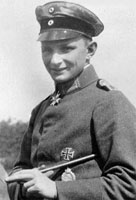Quoted Text
lozenges, streaks and now stripes. You are spoiling us Stephen.
I really appreciate you sharing your hard won research on all this stuff.
with 3 d.7 in the build queue you have my full attention.
[pulls up chair]
No worries Jaypee and Terri.

Shall we begin? Note first the propeller.at left we have a Wolff Co. type at right an Axial Co. type with a Rupp quick release prop hub.
The Rupp's were associated with the late model BMW motor installations. ( Post Sept. 1918.) This is abundantly clear with the type of radiator that is on this aircraft as well. Note the narrow center section is solid and not screened.
The specifics on the machines is that they are two differnet airframes. The striping and the motor variations help with that but are the pilots the same?
Now for some specifics the fellow at left inthe above image is Ltn. Hans Kirchstein and he is wearing an Orden Pour le Merite at his throat. The other fellow at right is not wearing this award. More later on him. Here below is a better image of him holding a putter.

Hans Kirschstein served with the 3rd Pioneer Battalion in Poland, France and Macedonia where he contracted malaria in 1915. In February 1916 he transferred to the air service and was sent to flying school in May. Upon graduating he was posted to FA 19 where he was awarded the Iron Cross, second class, for bombing Dover, England. In 1917 Kirschstein served with FA 256 and FA 3. He attended Jastaschule in February 1918 and was posted to Jasta 6 on 13 March 1918. With this unit he earned the Iron Cross, first class, and the Knight's Cross with Swords of the Royal House Order of Hohenzollern. Having scored 24 victories,
he assumed command of Jasta 6 on 10 June 1918. After downing three more enemy aircraft, bringing his total to 27, he was awarded the Blue Max on 24 June 1918. Soon afterwards, On 16 July 1918 Kirschstein was killed in a crash on a return flight from Fismes in a Hannover CL.II piloted by Leutnant Johannes Markgraf. A board of inquiry later concluded the crash was the result of pilot error.
So the photo at left was taken between 24 June and 10 July 1918.
Since he died in another machine this one at left was probably passed on to the next commander of Jasta 6.
























